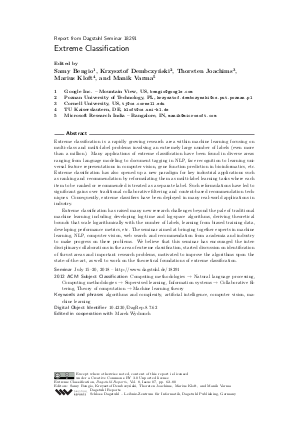Extreme Classification (Dagstuhl Seminar 18291)
Authors Samy Bengio, Krzysztof Dembczynski, Thorsten Joachims, Marius Kloft, Manik Varma and all authors of the abstracts in this report
-
Part of:
Issue:
Dagstuhl Reports, Volume 8, Issue 7
Part of: Volume: Dagstuhl Reports, Volume 8
Part of: Journal: Dagstuhl Reports (DagRep) - License:
 Creative Commons Attribution 3.0 Unported license
Creative Commons Attribution 3.0 Unported license
- Publication Date: 2019-01-22
File

PDF
DagRep.8.7.62.pdf
- Filesize: 5.48 MB
- 19 pages
Document Identifiers
Subject Classification
Keywords
- algorithms and complexity
- artificial intelligence
- computer vision
- machine learning
Metrics
- Access Statistics
-
Total Accesses (updated on a weekly basis)
0PDF Downloads0Metadata Views
Abstract
Extreme classification is a rapidly growing research area within machine learning focusing on multi-class and multi-label problems involving an extremely large number of labels (even more than a million). Many applications of extreme classification have been found in diverse areas ranging from language modeling to document tagging in NLP, face recognition to learning universal feature representations in computer vision, gene function prediction in bioinformatics, etc. Extreme classification has also opened up a new paradigm for key industrial applications such as ranking and recommendation by reformulating them as multi-label learning tasks where each item to be ranked or recommended is treated as a separate label. Such reformulations have led to significant gains over traditional collaborative filtering and content-based recommendation techniques. Consequently, extreme classifiers have been deployed in many real-world applications in industry. Extreme classification has raised many new research challenges beyond the pale of traditional machine learning including developing log-time and log-space algorithms, deriving theoretical bounds that scale logarithmically with the number of labels, learning from biased training data, developing performance metrics, etc. The seminar aimed at bringing together experts in machine learning, NLP, computer vision, web search and recommendation from academia and industry to make progress on these problems. We believe that this seminar has encouraged the inter-disciplinary collaborations in the area of extreme classification, started discussion on identification of thrust areas and important research problems, motivated to improve the algorithms upon the state-of-the-art, as well to work on the theoretical foundations of extreme classification.
Cite As Get BibTex
Samy Bengio, Krzysztof Dembczynski, Thorsten Joachims, Marius Kloft, and Manik Varma. Extreme Classification (Dagstuhl Seminar 18291). In Dagstuhl Reports, Volume 8, Issue 7, pp. 62-80, Schloss Dagstuhl – Leibniz-Zentrum für Informatik (2019)
https://doi.org/10.4230/DagRep.8.7.62
BibTex
@Article{bengio_et_al:DagRep.8.7.62,
author = {Bengio, Samy and Dembczynski, Krzysztof and Joachims, Thorsten and Kloft, Marius and Varma, Manik},
title = {{Extreme Classification (Dagstuhl Seminar 18291)}},
pages = {62--80},
journal = {Dagstuhl Reports},
ISSN = {2192-5283},
year = {2019},
volume = {8},
number = {7},
editor = {Bengio, Samy and Dembczynski, Krzysztof and Joachims, Thorsten and Kloft, Marius and Varma, Manik},
publisher = {Schloss Dagstuhl -- Leibniz-Zentrum f{\"u}r Informatik},
address = {Dagstuhl, Germany},
URL = {https://drops.dagstuhl.de/entities/document/10.4230/DagRep.8.7.62},
URN = {urn:nbn:de:0030-drops-101739},
doi = {10.4230/DagRep.8.7.62},
annote = {Keywords: algorithms and complexity, artificial intelligence, computer vision, machine learning}
}
